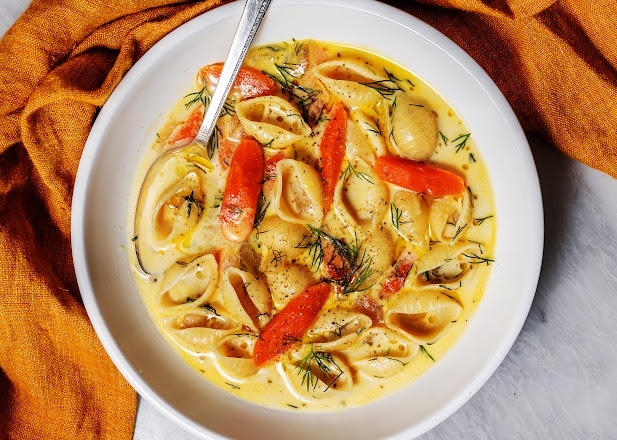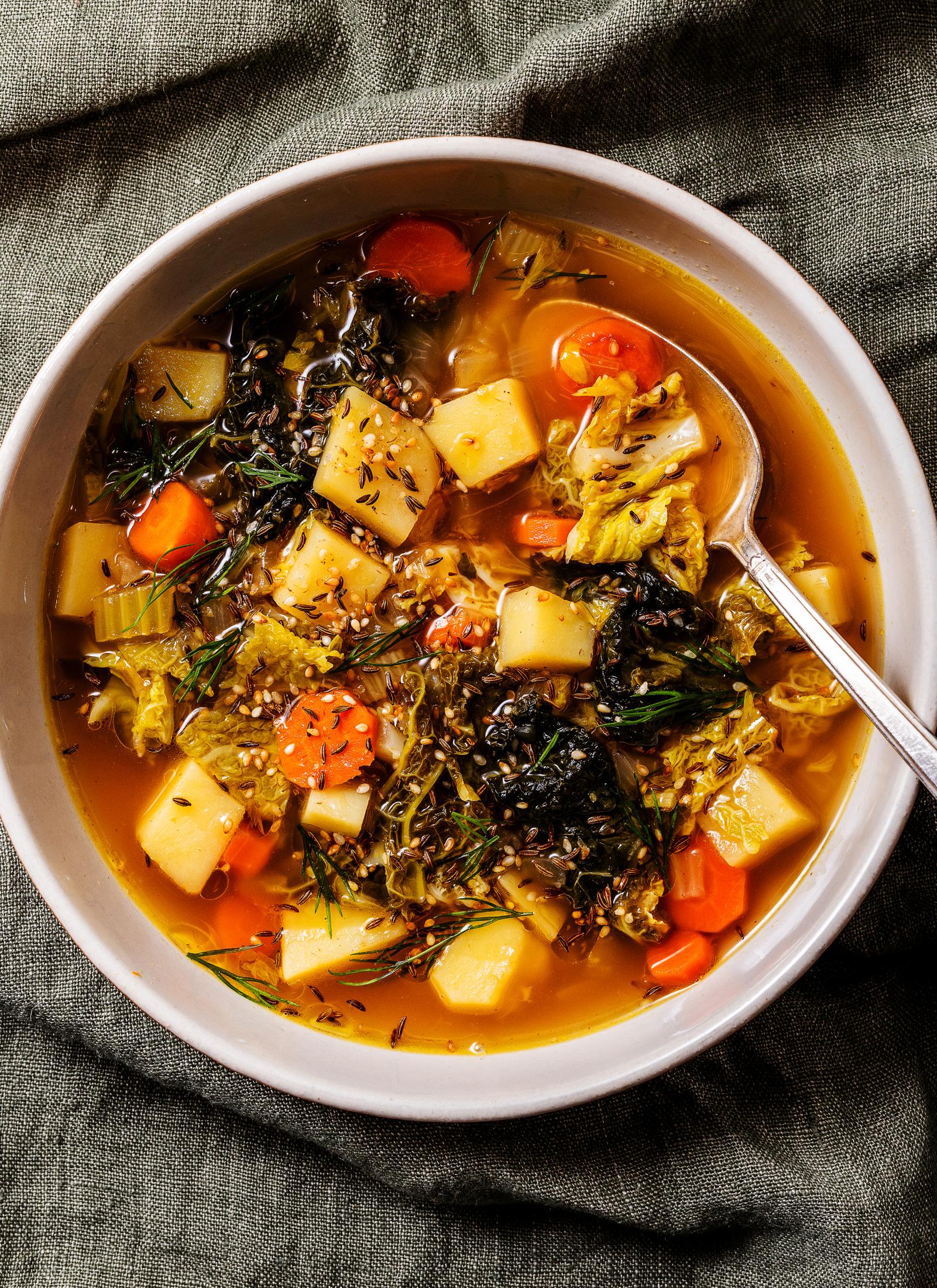
Crisp weather calls for cozier cooking. And in one Baltimore kitchen, a jack-of-all-trades cookbook author is whipping up gorgeous broths, stews, noodle bowls, and hearty pasta dishes that prove the adage that your eyes eat first.
One scroll through Kylie Perrotti’s Instagram feed, @triedandtruerecipes, is all it will take to induce hunger pangs. The author, photographer, and food blogger has compiled her “easy and elegant” recipes into two books already, and her third—which will feature a collection of five-ingredient vegan dishes—is due out next year.
We recently caught up with Perrotti to learn more about her roots, cooking philosophies, and her new book, The Plant-Based Five Ingredient Cookbook: Fast and Flavorful Recipes Made Vegan. Plus, she shares two recipes that will be sure to warm your soul at the end of a chilly day.
Are you from Baltimore originally?
I’m from Pennsylvania. I moved to Baltimore in 2013, and then in 2015, my boyfriend at the time, now my husband, and I moved to New York City and stayed there until 2018. And then we moved back. So we’ve kind of bounced around a little bit.
How did you first start food blogging?
I don’t really know exactly how it happened, honestly. It kind of was organic. I wanted to get better at food photography, so I was just photographing things that I made. And the photos were terrible. So I started this blog with the premise of testing recipes from other websites and grading them. I just wanted to create them and practice my food photography. That lasted, like, two recipes and I got bored with it, so I just started writing my own. And I grew from there.
Do you take the photographs for your books, as well?
Everything on my site, everything on my Instagram, they’re all my photographs. They don’t source that part of it out.
What is your cooking background?
I don’t have one. I’m self-taught. I grew up cooking. None of my family is, you know, trained or anything. It’s just something we like to do.
The concept for your third book is creating vegan recipes using only five ingredients. How did that idea come about?
In high school I was vegan for a year and a half or something like that. I wrote one cookbook, and then the publisher came back and said, “Hey, would you want to do a vegan cookbook?” And I did it. I wanted to try it and I thought it’d be kind of a fun challenge. And I found that I actually really liked cooking vegan recipes and cooking without meat.
It was a challenging book to write. I had to really think about what constitutes five ingredients, because I can’t count water, salt, and pepper—otherwise, that’s a recipe right there. I guess the process was really just thinking about things that I had made in the past and how I could reduce them down to five ingredients without losing the quality of the dish. For example, I made this broth in the past, and it occurred to me that it didn’t have very many ingredients, so I could do something vegan. I kind of get a spark of an idea and then I get really obsessed with it.
After writing this book, would you encourage people to experiment with plant-based cooking?
I think so. Just based on what I’ve read, it’s better for the environment, it’s better for your health. So, I think if you can get to a point where you do just even one meal a week, I think it’s an important step to take.
Caraway-Cabbage Soup
Inspired by sarmale–cabbage rolls of Romania–the cabbage in this soup is boiled briefly in water that has been spiked with vinegar to approximate the flavor of the pickled cabbage leaves traditionally used for sarmale. This recipe uses a few techniques to deliver bold, savory flavors from just a few ingredients. First, cabbage boiled in vinegar adds a delicious punch to the soup. Next, a quick toast of the caraway seeds before pulverizing them in a mortar and pestle brings out their flavor. Finally, a splash of vinegar added to the soup before serving amplifies the flavor of the cabbage.

Tip: I recommend serving this with more toasted, lightly crushed caraway seeds. If you have sesame seeds in your pantry, toast them with the caraway seeds for garnish and crush them together with a sprinkle of salt. It adds a wonderful, crunchy, fragrant finish to the soup. Alternatively, a sprinkle of your favorite everything bagel seasoning on top is also an excellent way to finish this soup.
Prep time: 20 minutes
Cook time: 45 minutes
Servings: 4
Ingredients
- ⅓ cup plus 1 tablespoon distilled white vinegar, divided
- 1 head savoy cabbage, cored and quartered
- 1 tablespoon caraway seeds
- 1 tablespoon neutral oil
- 2 cups fresh or frozen mirepoix (carrot, celery, and/or onion)
- 1 pound Yukon gold potatoes, cubed
- 6 cups water or vegetable stock
- Salt and pepper to taste
- 2 teaspoons toasted sesame and caraway seeds or everything bagel seasoning, optional for garnish
- Fresh dill fronds, optional, for garnish
Instructions
Prepare the cabbage: Bring a large pot of water to a boil. Add a generous sprinkle of salt and ⅓ cup distilled white vinegar. Add the cabbage and push it down into the water to ensure all the leaves are submerged. Boil for five to seven minutes until bright green and all of the cabbage quarters have softened. Transfer the cabbage to an ice bath and let stand for 10–15 minutes. Pour the water out of the soup pot and carefully wipe out the pot. Return it to the stovetop. Remove the cabbage from the ice bath and squeeze out the excess water. Transfer to a cutting board and roughly chop. Set aside.
Toast the caraway seeds: Place a small skillet on the stove and turn the heat to medium-high. Once hot, add the caraway seeds and toast for one minute, turning often. Transfer to a mortar and pestle and pulverize until lightly crushed. Alternatively, place in a gallon freezer bag and crush with a rolling pin or heavy-bottomed pot. Set aside.
Prepare the soup: Add one tablespoon of neutral oil to the soup pot and turn the heat to medium. Add the mirepoix and cook, stirring occasionally, for six to seven minutes until it just begins to soften. Season with salt and pepper. Add the toasted, lightly crushed caraway seeds and cook for one minute.
Simmer the soup: Add the potatoes and toss to coat. Season again with salt and pepper. Pour in six cups of water or vegetable stock and bring to a boil. Reduce heat and simmer for 15–20 minutes or until the potatoes are almost fork-tender.
Finish the soup: Taste the soup and adjust the seasoning. Add the chopped cabbage and the remaining one tablespoon of distilled white vinegar. Simmer for an additional 10–15 minutes or until the potatoes are completely cooked through. Turn off the heat.
To serve: Ladle the soup into bowls. Garnish with toasted sesame and caraway seeds and a few dill fronds, if you like. Enjoy!
Creamy Lemon-Dill Broth
This lemon-dill broth is an herby, zippy, show-stopping cream-based soup broth perfect for short pasta shapes, like farfalle, orecchiette, or conchigliette. I prefer the medium-sized shell–conchiglie–because it captures so much more of the broth in each bite. Whichever variety of small pasta you use, you’ll love the warmth this soup brings on a cold evening.
Tip: To prevent swelling in the broth, cook only the pasta you intend to eat at dinner and boil it separately from the cream broth. At dinner, ladle the warm broth over the cooked pasta. Extra pasta can be refrigerated separately from the broth, and leftovers can be reheated gently on the stove together. If you’re not keen on serving this with pasta, add your favorite soup vegetables to the broth instead. Diced potatoes, white beans, turnips, mushrooms, and celery can bulk up the base of the soup–and should be added with the carrots–while peas, edamame, spinach, and green beans can be added at the end for a bit of bright green crispness.
Prep time: 10 minutes
Cook time: 25 minutes
Servings: 4
Ingredients
- 2 tablespoons olive oil
- 1 yellow onion, peeled and diced
- 4 carrots, peeled, trimmed, and sliced into rounds on an angle
- 6 cups water or vegetable stock
- ¾ cup plant-based heavy cream
- 1 lemon, juiced and zested
- ⅔ cup fresh dill, roughly chopped; a pinch reserved for garnish
- Salt and pepper to taste
- 12 ounces pasta of choice, like shells, farfalle, or elbow macaroni, for serving
- Extra virgin olive oil, optional, for garnish
Instructions
Prepare the broth: Heat two tablespoons of olive oil in a soup pot over medium heat. Add the onion and carrots and cook for five to six minutes until they begin to soften. Season with salt and pepper. Pour in the water or vegetable stock and bring to a boil. Reduce heat to medium and rapidly simmer for 15 minutes. Season the water with salt and pepper.
Prepare the cream mixture: In a large measuring cup, combine the heavy cream, lemon juice and zest, and dill. Stir to combine and set aside.
Cook the pasta (optional): If serving with pasta, cook it now. Bring a large pot of salted water to a boil. Add the pasta and cook until al dente. Drain and set aside. Divide the cooked pasta between shallow bowls.
Finish the broth: Once the carrots are fork-tender, stir the cream mixture into the broth. Taste and adjust the seasonings to your preference. Simmer for five minutes. Turn off the heat.
To serve: Ladle the broth over the cooked pasta. Garnish with a few dill fronds and a drizzle of extra virgin olive oil. Enjoy!
